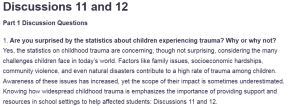Discussions 11 and 12
Part 1 Discussion Questions
- Are you surprised by the statistics about children experiencing trauma? Why or why not? Yes, the statistics on childhood trauma are concerning, though not surprising, considering the many challenges children face in today’s world. Factors like family issues, socioeconomic hardships, community violence, and even natural disasters contribute to a high rate of trauma among children. Awareness of these issues has increased, yet the scope of their impact is sometimes underestimated. Knowing how widespread childhood trauma is emphasizes the importance of providing support and resources in school settings to help affected students: Discussions 11 and 12.
- What signs or behaviors in Alex and Chiara suggest they’ve experienced trauma? Do these surprise you? Has this changed how you think about behavior and trauma? Alex and Chiara exhibit behaviors like difficulty concentrating, sudden mood shifts, and heightened sensitivity to stress, all common in children who have experienced trauma. These behaviors do not surprise me, as trauma can manifest in ways that often mimic behavioral or learning difficulties. This understanding does change how I view such behaviors. Rather than viewing them as simple discipline issues, it is essential to consider these signs as potential indicators of underlying trauma. This perspective shift encourages empathy and a trauma-informed approach to student support.
- Why should teachers understand how trauma impacts brain development? How can this help you better support and empathize with students? Understanding how trauma affects brain development is crucial for teachers because trauma can impair areas of the brain responsible for emotional regulation, memory, and learning. When teachers recognize that these behaviors may stem from neurological changes due to trauma, they can respond more empathetically and supportively rather than reacting with frustration (Koslouski et al., 2023). This understanding allows teachers to adopt more compassionate approaches, adapting teaching strategies to meet the needs of traumatized students and fostering a supportive classroom environment.
- What strategies can teachers use to create a classroom environment that supports children like Alex and Chiara? To create a trauma-supportive classroom, teachers can establish clear routines, set consistent expectations, and build trusting relationships with students. Strategies such as providing “cool-down” spaces for self-regulation, implementing predictable schedules, and incorporating mindfulness activities can help children feel safe and supported. Teachers can also use positive reinforcement and create a sense of belonging, allowing students to feel comfortable expressing emotions and building resilience against the effects of trauma.
Reference
Koslouski, J. B., Stark, K., & Chafouleas, S. M. (2023). Understanding and responding to the effects of trauma in the classroom: A primer for educators. Social and Emotional Learning: Research, Practice, and Policy, 1, 100004.
ORDER A PLAGIARISM-FREE PAPER HERE
We’ll write everything from scratch
Question 
Part 1 questions: Discussion Questions:
- Are you surprised by the statistics about children experiencing trauma? Why or why not?
- What signs or behaviors in Alex and Chiara suggest they’ve experienced trauma? Do these surprise you? Has this changed how you think about behavior and trauma?
- Why should teachers understand how trauma impacts brain development? How can this help you better support and empathize with students?
- What strategies can teachers use to create a classroom environment that supports children like Alex and Chiara?

Discussions 11 and 12
Textbook:
- Guiding Children’s Social Development and Learning: Theory and Skills 9th Edition
-
- Chapter 11. Fostering Self-Regulation in Children: The Role of Consequences
- Chapter 12. Handling Children’s Aggressive Behavior
- Seventh edition
-